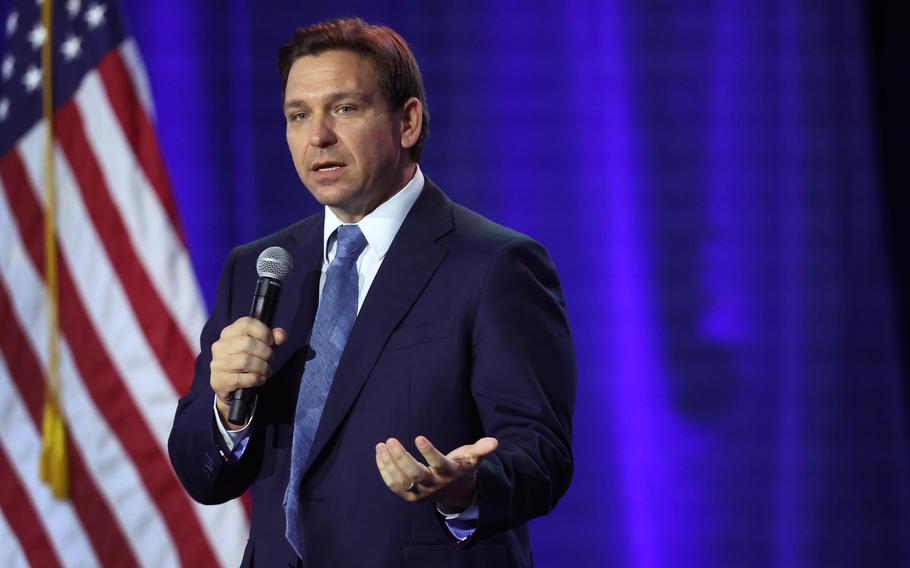
Florida Gov. Ron DeSantis speaks to Iowa voters gathered at the Iowa State Fairgrounds on March 10, 2023, in Des Moines, Iowa. (Scott Olson, Getty Images/TNS)
Last week, the Missouri House of Representatives passed a budget that eliminated aid to local libraries amid a dispute over the constitutionality of a state ban on “explicit material” in public schools. Last month, legislators in Tennessee approved a law restricting drag performances on public property or anywhere minors might be present. Over the past few years, Florida Gov. Ron DeSantis has presided over a series of policies attempting to eradicate critical race theory and other ideas associated with the political left from school curriculums.
The controversies over these and similar measures don’t merely demonstrate how acrimonious today’s culture wars have become. They also reveal how much politics has become an intergenerational battle, with older traditionalists against younger progressives.
The idea of a yawning generation gap tends to evoke associations with the bygone 1960s. But Americans are actually much more politically divided by age today than they were when Bob Dylan was warning the nation’s parents that “your sons and your daughters are beyond your command.” In the 1968 presidential election, voters under the age of 30 preferred Democratic nominee Hubert Humphrey to Republican opponent Richard Nixon by 9 percentage points, according to Gallup, while voters aged 50 or more opted for Nixon by 6 points.
Half a century later, according to survey data from the Pew Research Center, Joe Biden prevailed over Donald Trump by 24 points among voters under 30 and by 12 points among voters aged 30 to 49, even as Trump carried the over-50 vote by 5 points.
Young adults are not always liberal. Most voters under 35 supported Ronald Reagan and George H.W. Bush in the 1980s, and age differences in partisan preferences were fairly minor as late as the 2000 election.
But over the past two decades, the generations have increasingly separated themselves politically. Barack Obama was much more popular, and Trump much less popular, among younger voters than among their elders. Issues of race, gender and sexuality that divide voters along generational lines have become more central to the nation’s political debates. And changing demographic trends have ensured that millennials and members of Generation Z are much less likely than the middle-aged or elderly to identify as white, attend church regularly, or live in a rural area.
Conservatives are well aware that many younger Americans disagree with them politically. Negative characterizations of young adults as naive radicals who don’t understand the real world, or coddled “snowflakes” who demand special treatment, are common on conservative media platforms and circulate widely on Facebook, the older internet user’s social network of choice. (This intergenerational mockery can occasionally go both ways; some young liberals use “boomer” as an epithet and complain about the political “gerontocracy.”)
Many conservative leaders see younger generations’ relative liberalism as the result of the pernicious influence of left-aligned public institutions and industries. DeSantis and other Republican officials frequently defend their efforts to regulate social media platforms and gain control over state educational systems as necessary to dismantle liberal propaganda machines. Former Wisconsin Gov. Scott Walker blamed last week’s defeat of a conservative candidate in a state Supreme Court race — an election in which turnout among college students was unusually high — on “years of radical indoctrination on campus, in school, with social media, and throughout culture.”
Framing today’s politics as intergenerational warfare may provide Republicans with some short-term advantages. Appealing to older citizens can help win elections, as they are always the most reliable voters. The aging of the large baby boomer cohort also ensures that the median age of the national electorate will continue to increase.
But there are also risks to this approach. If Republicans could reduce the current Democratic advantage among rising generations before it further solidifies into a lifelong partisan attachment, it would pay electoral dividends for decades to come. It’s hard to imagine that Republican leaders will achieve much success by treating young adults’ political views with contempt or characterizing them as gullible victims of liberal brainwashing. Reversing the leftward drift of the young will probably require much more than removing some books — or drag queens — from the nation’s schools and libraries.
David A. Hopkins is an associate professor of political science at Boston College and the author of “Red Fighting Blue: How Geography and Electoral Rules Polarize American Politics.” This column does not necessarily reflect the opinion of the editorial board or Bloomberg LP and its owners.
©2023 Bloomberg L.P.
Visit bloomberg.com/opinion.
Distributed by Tribune Content Agency, LLC.